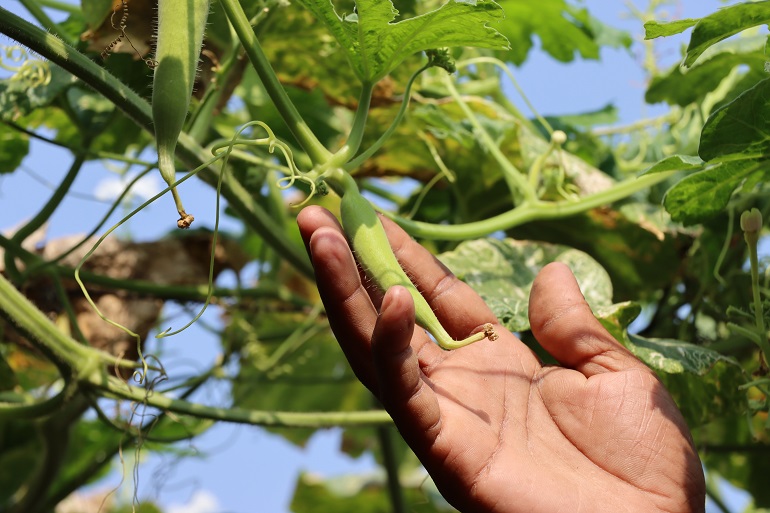Okra Water Requirements and Irrigation Systems

This post is also available in:
This post is also available in:
![]() Français (French)
Français (French) ![]() Deutsch (German)
Deutsch (German) ![]() Ελληνικά (Greek)
Ελληνικά (Greek)
Like other vegetable crops, okra can achieve its highest yields when additional irrigation is provided to maintain soil moisture at optimal levels. Providing sufficient water to developing plants is crucial for achieving good yields of high-quality pods.
To avoid salt injury, it is essential to conduct water conductivity tests before sowing the crop when using irrigation water, as okra is relatively susceptible to saline conditions.
How much water does okra need?
Because okra pods contain a lot of water, their yield and quality can quickly suffer from drought. Therefore, for optimal yields and high-quality produce, irrigation is essential. Irrigation can increase the size and weight of individual fruits or leaves/heads and prevent defects such as toughness, intense flavor, poor tip and pod fill, cracking, blossom-end rot, and misshapen fruit.
Frequent irrigation is necessary to achieve maximum yield. The moisture requirements of the soil vary depending on the crop and the stage of crop development. The availability of soil moisture depends on the amount of water in the soil and the soil type.
Soil type is critical when planning and using an irrigation system. Okra’s water requirements are up to 1.5 inches (4cm) of water per week or per 10 days during hot periods to maintain optimal growth. This requirement decreases to 0.75 inches (2 cm) per week during cooler seasons.
Hardening introduces seedlings to the same conditions in the growing field and is recommended since it increases the rates of seedlings’ survival. It’s done by gradually reducing watering and removing shade in the growing seedlings 1-2 weeks before transplanting.
What is the effect of drought stress on okra?
Growing okra in dry, non-irrigated areas can be risky during extremely dry weather. Most vegetables have shallow roots, and even short periods of stress lasting two to three days can harm marketable yield. Early water shortages during the crop’s development can delay maturity and reduce yields. Later in the growing season, moisture shortages can decrease quality even if total yields are not affected.
How do you water okra plants?- Irrigation systems
Various methods exist to water the okra crop, including overhead sprinklers, furrow irrigation, and drip systems. Drip irrigation is commonly used when there is insufficient water volume or pressure to meet the higher water requirements of overhead systems.
Drip systems are highly effective in distributing irrigation water as they can either apply water directly to the soil’s surface or subsurface using buried drip-tape. This irrigation method is particularly beneficial for crops grown on mulched beds.
Other advantages of using drip irrigation include the following:
- The ability to conduct other field operations during irrigation.
- Avoiding wetting of crop foliage, which can reduce crop disease pressure.
- The option to fertilize the crop through the drip system.
Read more:
- Okra Pests, Disease and Weed management
- Okra: Harvest, Yield, Storage, and Post-harvest handling
- Okra Water Requirements and Irrigation Systems
- Soil Preparation and Planting in Okra Farming
- Okra Propagation
- Okra Fertilization Requirements
- Okra: History, Nutritional Value, and Plant Information
- Hibiscus esculentus – Okra seeds
References:
Alsos, G.A.; Ljunggren, E.; Pettersen, L.T. Farm-based entrepreneurs: What triggers the start-up of new business activities? J. Small Bus. Enterp. Dev. 2003, 10, 435–443.
Barth, F. Economic Spheres in Darfur. In Themes in Economic Anthropology; Firth, R., Ed.; Routledge: London, UK, 1967. 75. Singer, A.E. Reflections on Eco-Preneurship. 2012.
Cavalli, D.; Cabassi, G.; Borrelli, L.; Geromel, G.; Bechini, L.; Degano, L.; Gallina, M. Pietro Nitrogen fertilizer replacement value of undigested liquid cattle manure and digestates. Eur. J. Agron. 2016, 73, 34–41.
Dijkxhoorn, Y., De, B., Piters, S., Brouwer, I., Hengsdijk, H. & Tichar, T. 2021. Enhancing fruit and vegetable consumption in low- and middle income countries through a food systems approach. The Hague, The Netherlands, Wageningen Economic Research.
FAO & WHO. 2019. Food control system assessment tool: Dimension A – Inputs and resources. Food safety and quality series No. 7/2. Rome, FAO.
Hoffmann, V. & Jones, K. 2021. Improving food safety on the farm: Experimental evidence from Kenya on incentives and subsidies for technology adoption. World Development, 143:
Jaffee, S., Henson, S., Unnevehr, L., Grace, D. & Cassou, E. 2019. The safe food imperative: accelerating progress in low- and middle-income countries. Agriculture and Food Series. Washington, DC, World Bank.
Kim, D.G.; Saggar, S.; Roudier, P. The effect of nitrification inhibitors on soil ammonia emissions in nitrogen managed soils: A meta-analysis. Nutr. Cycl. Agroecosyst. 2012, 93, 51–64.
Mencaroni, M.; Dal Ferro, N.; Furlanetto, J.; Longo, M.; Lazzaro, B.; Sartori, L.; Grant, B.B.; Smith, W.N.; Morari, F. Identifying N fertilizer management strategies to reduce ammonia volatilization: Towards a site-specific approach. J. Environ. Manag. 2021, 277, 111445.
Moumenihelali, H.; Sadighi, H.; Chizari, M.; Abbasi, E. Pluriactivity: An Entrepreneurial Strategy for Smallholder Farmers. J. Entrep. Agric. 2020, 6, 112–124.
Nitrogen Use Efficiency (NUE)—An Indicator for the Utilization of Nitrogen in Agriculture and Food Systems; EU Nitrogen Expert Panel: Wageningen, The Netherlands, 2015.
Sá, E.; Casais, B.; Silva, J. Local development through rural entrepreneurship, from the Triple Helix perspective. Int. J. Entrep. Behav. Res. 2019, 25, 698–716.
Sequeira, R.R. Factors Affecting Rural Entrepreneurship. Int. J. Res. Eng. Sci. Manag. 2020, 3, 239–240.
- https://extension.uga.edu/publications/detail.html?number=C627
- https://extension.uga.edu/publications/detail.html?number=C627
- https://www.uky.edu/ccd/sites/www.uky.edu.ccd/files/okra.pdf
- https://extension.okstate.edu/fact-sheets/okra-production.html








































































